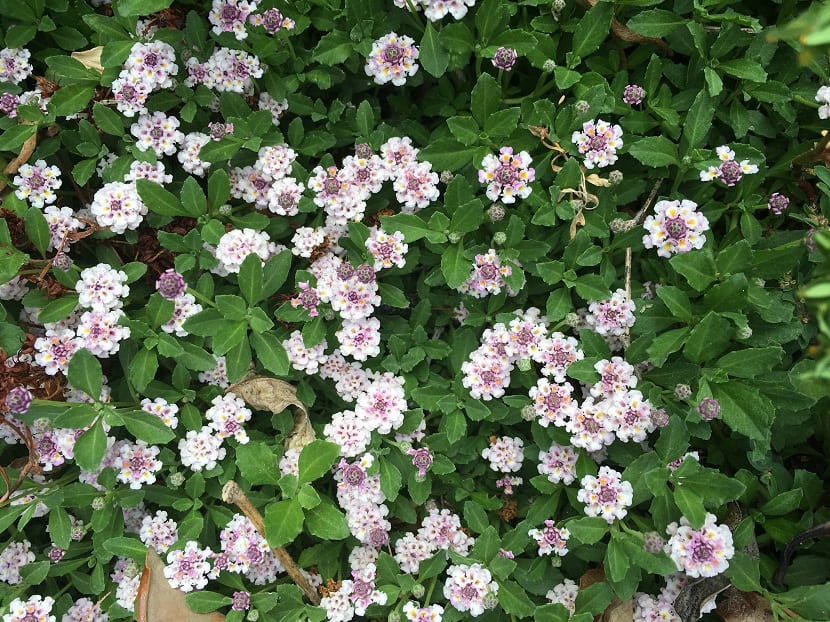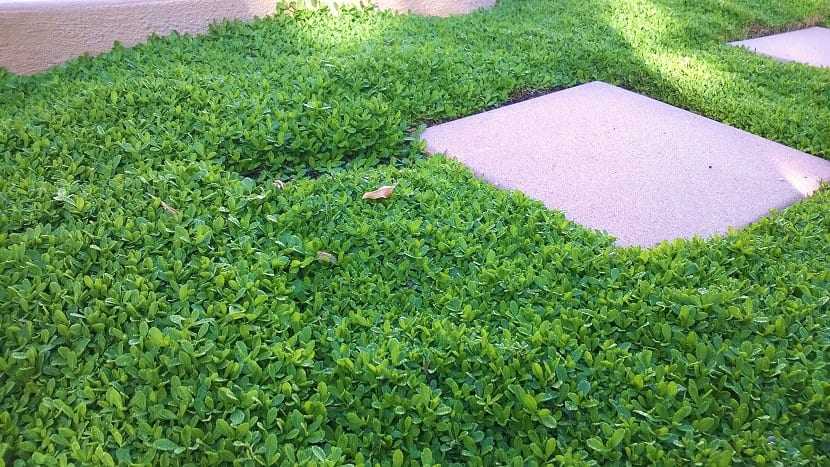
La Lippia nodiflora It is a herbaceous perennial plant, also known as Bella Carpet or simply Lipia. It belongs to the Verbenaceae family, is characterized by its small size and rapid growth. Because it is a upholstery plant it is great to replace the classic lawn. Some animals even use it as a source of nutrients for their food, in addition to being an excellent source of nectar for butterflies.
Features

This plant spreads along the ground developing roots as it spreads, often forms large mats. It is cultivated as an ornamental plant and is also given medicinal uses. The Lippia nodiflora It is a plant of little height, when it develops it quickly covers the ground with its extended stems that reach between 30 and 90 centimeters. Its small leaves are green, oval, with an irregular margin. During the winter period they turn reddish, which in a way, hinders their ornamental quality due to the lackluster appearance it acquires.
In relation to its foliage, this tends to cover the ground, withstands constant trampling and occasional vehicular passage. Its elongated stems latch onto the surface of the soil and spreads rapidly in all directions. It is an invasive plant. Its small leaves are crowded along the length of its stems and can completely cover the ground in the spring, summer and autumn seasons.
This becomes dry during the winter which is what gives the characteristic reddish tone of that season, at that time the stems become bare. Its foliage begins its cycle again in early spring, a time when the earth heats up.
The stems of the plant have a large number of small and aromatic flowers, they are found in groups of concentrated flowers, they have an approximate diameter of 2.5 mm. They are often seen as white and yellow towards the center, sometimes pink. They constantly attract bees Due to its melliferous nature, it is therefore not recommended if you have children or a garden at home.
Cultivation of Lippia nodiflora
To plant the Lipia prepare the land as if you were going to plant some plant, then irrigate with plenty of water. When 5 or 6 days have elapsed you will be able to observe the appearance of weed seedlings. Once this has occurred, then proceed to remove weeds manually or with the use of a herbicide indicated with low environmental impact. Apply the product with a small sprayer, make sure that the content does not reach the nearby plants. After approximately 48 hours, you can sow the Lippia. Although it is a species that tends to compete advantageously with weeds, it is best to eliminate it as soon as possible, so that you ensure its proper development.

You can plant 5 to 15 seedlings per square meter depending on the effect you want. For example, if you expect quick coverage, the density of the number of seedlings ranges from 10 to 12 per square meter. Finally, water abundantly until the seedlings are fully rooted. Once this happens you can progressively reduce the irrigation until it is interrupted.
In those slightly gentler geographical areas you can plant the Lipia during the autumn, facilitating the enough time to take root well in the ground and withstand the drought during the summer. Of course and in another field, it is best to plant it in spring, free of the risk of freezing. Once the Lipia is planted in the ground it takes root strongly and it will begin to develop in all directions, until it fully forms the grass of the selected area. In relation to the light conditions, it grows very well; both in full sun and in partial shade.
Despite its small size and appearance, the Lippia nodiflora It has an interesting resistance to drought, even when exposed to extreme conditions. When the area has low irrigation, it tends to shrink in size, its leaves shrink and the carpet that forms the plant becomes thinner. In temperate zones it retains the same appearance throughout the year.
As regards the nature of the soil, it is an undemanding plant. Tolerates light and clayey soils, preferably well drained. However, do not rely on the strength of Lippia, as temperatures below -10ºC can cause serious damage to the plant.
You do not have to worry much about the issue of watering, this plant has the capacity to withstand continuous trampling. No need to pay or collect. A good watering carried out once or twice a month in hot season is enough, although it also has the characteristic that once it is rooted, it can withstand drought, in which case the species returns to rest at the end of summer.
Management
It is a very resistant plant to diseases and attacks from the plague, as well does not require to be fertilized. However, it is recommended that you apply a type of granular fertilizer during the spring or a slow release fertilizer, giving preference to formulas that contain nitrogen and potassium. If you repeat this procedure in autumn, it can make the plant better withstand the cold season.
Advantages and disadvantages
- Easy cultivation and fast growth.
- Excellent resistance to trampling.
- Decorative flowering for a long time.
- Resistant to salt by the sea.
Uses

Because of his tussock upholstery character, It is a valid option to traditional grass, very resistant to footfalls and drought. Its use in the kitchen is limited to the preparation of a substitute drink for tea, due to its particular herbaceous flavor. In alternative medicine, used as a pain reliever and antibacterial, antibacterial, diuretic, for a better menstruation and parasiticide. It is used in the treatment of hookworm. It is also used to relieve fever, cough, and cold. The root is used in the treatment of digestive problems.
Ideal for arranging floral lawns with natural magic, even covering a slope, it also finds its place in dry stone wall cracks and in rock gardens. If you want to plant between slabs, an edge of a hallway or a staircase blooms, this plant will not disappoint you!
Nice plant, I had never heard of it.
I have been searching for seeds or cuttings for a long time, but it is very difficult to find. If anyone knows where to get it, please share the information.
Thank you
Hi carlos.
We recommend looking at Amazon, or ebay. In this last site you may find seeds.
Regards!
Hello, where can I buy the lippia?
Hello Veronica.
You can get seeds by clicking here. Greetings!
Excellent information, thank you very much, you always get me out of doubts and I am happy to consult them. greetings from Mexico. 🙂
Thank you very much, Andrea. We are glad to hear that you find our tips useful 🙂
Hi! Really, I have looked for a vendor, nursery or supplier that will send me a shipment to Mexico and nothing, simply and simply in Mexico it is impossible to get it and nobody sends here. Does anyone know where I can buy it? Please, I am interested and excited to reproduce it as a sustainable alternative to grass.
Where can you buy in Argentina? I can't get it in Rosarito
Hi Patricia.
Maybe they can help you in an online plant nursery. It is that we are a little far away, in Spain.
Good luck!